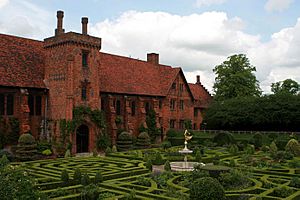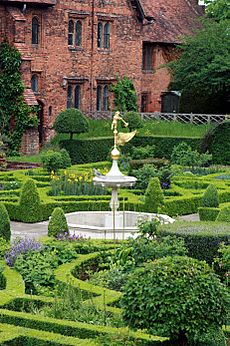Hatfield House facts for kids
Quick facts for kids Hatfield House |
|
|---|---|
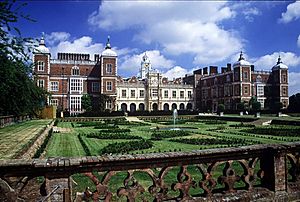
South-facing view of Hatfield House
|
|
| Type | Prodigy house |
| Location | Hatfield, Hertfordshire |
| OS grid reference | TL 23715 08394 |
| Built | 1607-1612 |
| Architectural style(s) | Jacobean |
| Owner | Robert Gascoyne-Cecil |
|
Listed Building – Grade I
|
|
| Official name: Hatfield House | |
| Designated | 6 February 1952 |
| Reference no. | 1173363 |
| Official name: Hatfield House | |
| Designated | 11 June 1987 |
| Reference no. | 1000343 |
| Lua error in Module:Location_map at line 420: attempt to index field 'wikibase' (a nil value). | |
| The Old Palace, Hatfield House | |
|---|---|
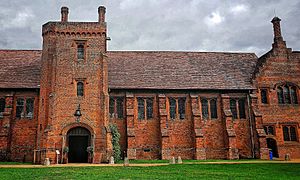
The Old Palace, Hatfield House
|
|
| Type | Bishop's Palace |
| Location | Hatfield |
| Area | Hertfordshire |
| Built | c.1480 |
| Architectural style(s) | Medieval and Tudor |
|
Listed Building – Grade I
|
|
| Official name: The Palace | |
| Designated | 6 February 1952 |
| Reference no. | 1348152 |
| Lua error in Module:Location_map at line 420: attempt to index field 'wikibase' (a nil value). | |
Hatfield House is a famous old country house in Hatfield, England. It is known for its beautiful design and large park. The house was built a long time ago, in 1611. It is a great example of Jacobean architecture, which was popular during the time of King James I.
The house was built by Robert Cecil, 1st Earl of Salisbury. He was a very important person, serving as the chief minister to King James I. Hatfield House is still the home of the Cecil family today. You can visit it and explore its history.
The estate also has parts of an even older palace. This old palace was once the childhood home of Queen Elizabeth I. There's even a special tree, called Queen Elizabeth's Oak, where she is said to have learned she would become queen.
Contents
A Royal History
The Old Palace and Young Elizabeth
Before the current Hatfield House was built, there was a Royal Palace on the same land. Only a small part of this old palace still stands today. This palace was very important to Queen Elizabeth I. She spent much of her childhood there.
The old palace was built in 1497 by an important church leader, John Cardinal Morton. It had four wings that formed a square around a central courtyard. Later, King Henry VIII took over the palace.
Both King Edward VI and the future Queen Elizabeth I grew up at Hatfield Palace. Henry VIII's oldest daughter, Queen Mary I, also lived there for a few years. She was sent there as a punishment for not agreeing with her father's marriage to Anne Boleyn.
Elizabeth's Challenges and Coronation
When Elizabeth was 15, she faced trouble at Hatfield. She was suspected of planning to marry Thomas Seymour without permission. Her home and servants were searched, and she was questioned. Elizabeth bravely defended herself. Seymour was later executed for other serious crimes against the crown.
After being held in the Tower of London by her sister, Queen Mary, Elizabeth returned to Hatfield. It is said that she learned she would become queen under the Queen Elizabeth Oak on the estate. This happened after Mary's death in November 1558. Soon after, Elizabeth held her first important meeting as queen in the Great Hall of Hatfield.
Queen Elizabeth's Treasures
Hatfield House is a popular place to visit because it has many items linked to Queen Elizabeth I. You can see her gloves and a pair of silk stockings. These stockings are believed to be the first ever in England.
The house's library has a very long scroll, about 22 feet (6.7 meters) long. It shows Queen Elizabeth's family tree, going all the way back to Adam and Eve. In the Marble Hall, you can see the famous "Rainbow Portrait" of Elizabeth.
Building the New Hatfield House
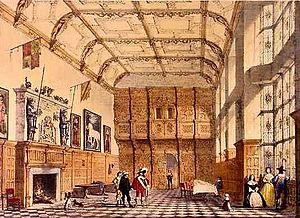
King James I, who became king after Elizabeth, did not like the old palace. In 1607, he gave it to his chief minister, Robert Cecil, 1st Earl of Salisbury. In return, Cecil gave the King his own family home, Theobalds.
Cecil loved building, so he tore down three parts of the old royal palace in 1608. He used the bricks to build the beautiful Hatfield House we see today. The house has amazing original features from that time. These include a grand wooden staircase with rich carvings and a rare stained glass window in the private chapel.
Hatfield House During World War II
During World War II, Hatfield House played a special role. It became the first "Civil Resettlement Unit." These units helped British soldiers who had been prisoners of war return to normal life. The peaceful and grand setting of Hatfield was thought to be very good for these men. In July 1945, King George VI and Queen Elizabeth, the Queen Mother, visited the unit at Hatfield. This visit was widely reported in the news.
Exploring the Gardens
The gardens at Hatfield House are huge, covering about 42 acres (170,000 square meters). They were first designed in the early 1600s by John Tradescant the elder. Tradescant traveled around Europe and brought back many new trees and plants to England.
The original gardens had orchards, fountains, sweet-smelling plants, and special flowerbeds. They also had herb gardens and a maze. The gardens were not well cared for in the 1700s. However, work to restore them began in the Victorian era and continues today.
Tanks in the Garden
During World War I, the grounds of Hatfield House were used for a very unusual purpose. They were used to test the first British tanks! An area was dug up with trenches and craters. It was covered with barbed wire to look like the battlefields in France.
To remember this, the only surviving Mark I tank was kept at Hatfield from 1919 to 1970. It was then moved to The Tank Museum.
Visiting Hatfield House
You can visit the State Rooms of Hatfield House on guided tours during the week. On weekends, you can explore the house at your own pace. Fridays are special "Garden Connoisseur's Days." On these days, the house is open for guided tours and groups interested in the gardens. There are also five miles of marked walking trails to enjoy.
Hatfield House in Movies and TV
Hatfield House is a very popular place for filming movies and TV shows. Its historic look makes it perfect for many different stories. Some of the well-known productions filmed here include:
- Greystoke: The Legend of Tarzan, Lord of the Apes (1984)
- Orlando (1992)
- Batman (1989)
- Lara Croft Tomb Raider: The Cradle of Life
- Charlie and the Chocolate Factory (2005)
- The New World (2005)
- Elizabeth: The Golden Age (2007)
- Hot Fuzz (2007)
- Shakespeare in Love (1998)
- Sherlock Holmes (2009)
- Paddington (2014)
- The Crown
- Enola Holmes
- Bridgerton (2020)
- Paddington 2
Images for kids
See also
 In Spanish: Hatfield House para niños
In Spanish: Hatfield House para niños


